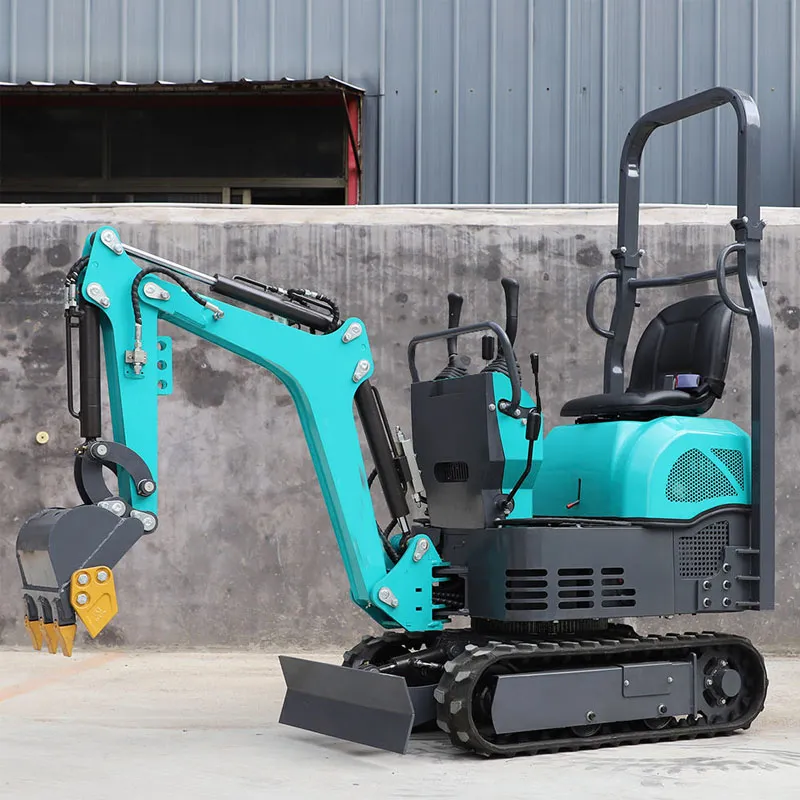
Mini excavators (also known as micro or small excavators) are hydraulic excavation machines with an operating weight typically ranging from 0.7 to 6 tons and a bucket capacity of 0.04 to 0.3 cubic meters. They feature a compact design and high maneuverability, specifically engineered for narrow spaces and light-duty construction projects. According to China's latest industry standards for 2025, the core features of mini excavators include a compact structure with an average width of less than 1 meter, no special license required for transportation, a modular design allowing for quick replacement of over 20 types of attachments such as breakers and augers, and standard GPS positioning and remote fault intelligent diagnosis systems.
Hydraulic Excavation System: Controls arm, boom, and bucket movements via hydraulic cylinders to perform digging, loading, and bulldozing operations. The turntable, tracks (or tires), and bucket are all hydraulically driven.
Multi-Functional Attachments: Supports quick replacement of hydraulic breakers, augers, screening buckets, grapples, and more to perform tasks such as pile driving, landscaping, mining, and small-scale demolition.
Driving and Control System: Some high-end models offer enclosed cabins, air conditioning, electronic controls, and even remote monitoring systems to enhance comfort and efficiency.
Mini excavators are widely used in various scenarios:
Urban Construction and Municipal Engineering: Such as street repairs, pipeline laying, sidewalk renovations, and terrain leveling; they have a small footprint and can operate on sidewalks or in narrow alleys.
Landscaping and Landscape Engineering: Used for planting trees, landscaping, soil leveling, trenching, and pipe laying.
Agricultural and Farming Operations: Tasks such as fertilizer trench digging, drainage, and irrigation channel construction can be completed using attachments like drills and tilling buckets.
Indoor or Underground Space Construction: Such as indoor spaces, underground garages, or underground facility repairs. Electric or low-emission models can be used in areas with poor ventilation.

Compact size and high flexibility: More efficient than traditional large excavators in narrow or crowded areas and less likely to damage surrounding facilities.
Cost-effective: Lower rental or purchase costs, fuel consumption, and maintenance costs, suitable for small construction teams or sporadic tasks. The average fuel consumption of mini excavators produced in China is approximately 2.1 L/h, a decrease of about 37% compared to 2015.
Mini excavators are priced between US$10,000 and US$40,000 per unit. The global market was valued at approximately US$6.92 billion in 2022 and is projected to grow to approximately US$12.5 billion by 2032, with a compound annual growth rate of approximately 4–5%.
Key market drivers include urban development, infrastructure upgrades, increased demand for municipal landscaping, and rapidly growing demand in agriculture, environmental protection, and indoor operations.
Electric and Hybrid Power
Electric propulsion technology is rapidly penetrating the construction machinery sector, with several electric mini excavator models already available. It is expected to become the mainstream trend in the coming years. Its advantages include zero emissions, low maintenance, and low noise, making it particularly suitable for urban, tunnel, underground, and nighttime construction environments.
Automation and Intelligent Applications
Latest technological advancements such as ExACT and autonomous excavation planning systems enable autonomous path planning, LiDAR and camera-assisted operation, and even fully automated excavation processes without human intervention. In the future, integration with IoT and remote control systems will enable remote monitoring of equipment and automated task execution.
IoT and Attachment Integration Management
Through remote status monitoring, real-time fault diagnosis, precise control, and attachment coordination management, operational efficiency is enhanced, downtime is reduced, and job quality tracking and big data analysis support are enabled.
Multi-Attachment Ecosystem and Modular Platform
Future markets will increasingly rely on modular platform designs, combining a universal chassis with a multi-functional attachment ecosystem to enable applications across scenarios such as excavation, material handling, crushing, loading, and landscaping, thereby improving equipment utilization and return on investment.
Mini excavators, with their compact structure, multi-functional attachments, high cost-effectiveness, and energy-saving and environmentally friendly characteristics, are becoming important engineering vehicles in multiple fields such as municipal, landscaping, agriculture, water conservancy, and industrial renovation. In the future, with the continuous development of electric technology, automated control, and attachment ecosystems, their role in the engineering vehicle industry will become even more significant, providing more possibilities for engineering construction while driving the entire industry toward intelligent, green, and efficient development.